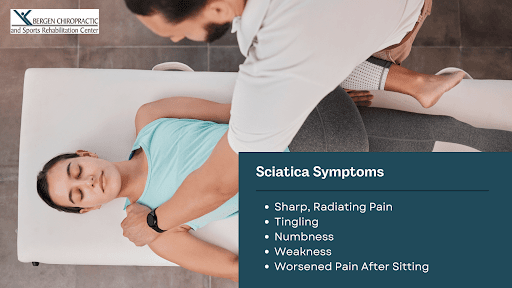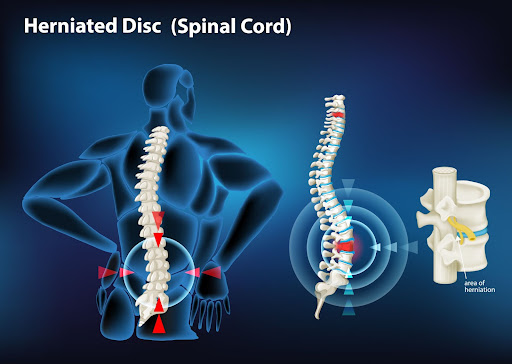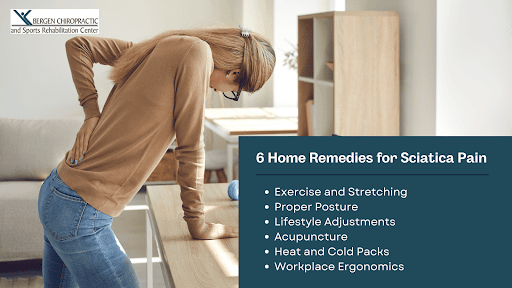That pesky sciatica pain can put a damper on your day.
But guess what? There’s encouraging news on the horizon!
Chiropractic care has been a game-changer for many sciatica patients, offering a path to relief.
Dive in to discover how the magic hands of a chiropractor can help soothe that stubborn sciatic pain!
Key Takeaways
- Sciatica pain is characterized by sharp or radiating pain, tingling or numbness, and weakness, often resulting from causes like herniated discs, spinal stenosis, and muscle spasms.
- Chiropractic care provides several effective techniques, including ultrasound therapy and spinal manipulation, to alleviate sciatic pain.
- Adopting home remedies such as exercise, stretching, proper posture, and lifestyle adjustments, coupled with chiropractic treatments, offers a drug-free approach to managing sciatic pain and discomfort.
How Do We Define Sciatica Pain?
Sciatica describes the discomfort or pain resulting from pressure on the sciatic nerve — one of the longest in our body, starting from the lower back and extending down to the feet.
Sciatica occurs when there’s an issue causing this pressure, leading to pain, tingling, or numbness along the path of the sciatic nerve. It’s essential to recognize these symptoms to understand when the body is signaling a problem with the sciatic nerve.
5 Sciatica Symptoms

- Sharp Pain: This could make it tough to stand up or even walk.
- Radiating Pain: Often, sciatic pain starts in the lower back and travels down one leg. It may feel like a sharp zap, a burning sensation, or an ache.
- Tingling or Numbness: These sensations often occur in the leg or foot on one side of the body.
- Weakness: Sometimes, the leg or foot might feel weak or clumsy.
- Worsened Pain After Sitting: Sitting for a while might worsen your sciatic pain.
5 Causes of Sciatica Pain
There are several culprits to look at when trying to figure out the underlying cause of sciatica.
Let’s break down some of the root causes:
- Herniated Disc: Think of your spine as a stack of donuts. If the jelly in one of those donuts squirts out a bit, it can bug the nearby nerve. That’s what happens during disc herniation.

- Spinal Stenosis: Over time, the hallway in our spine where the nerves reside can get cramped, putting pressure on the nerves.
- Piriformis Syndrome: The piriformis muscle is located deep within the gluteal region. Undue contractions or muscle spasms may compress the sciatic nerve.
- Bone Spurs or Tumors: These growths that develop on the spine can press against the nerve.
- Injury or Infection: Sometimes, an injury to the back or an infection will irritate the sciatic nerve.
Can a Chiropractor Help With Sciatica?

Chiropractors are the back experts who help align your spine and make sure everything is sitting right. When it comes to sciatica pain, they’ve got several effective techniques up their sleeves to help out:
First, you have ultrasound therapy, which uses sound waves to create a gentle heat and increase blood flow to the affected area. The increased blood flow eases muscle stiffness, pain, and swelling. By alleviating these symptoms, your body will be better equipped to heal the irritated sciatic nerve.
Second, we’ve got spinal manipulation through chiropractic adjustments — the bread and butter of what chiropractors do. By ensuring the lower spine is aligned correctly, spinal manipulation reduces that nasty pressure causing sciatica pain.
Cold laser therapy is another nifty trick up every chiropractor’s sleeve. When you go in for a session, your chiropractor will use a handheld device that emits light. This light goes through your skin and reaches the areas causing pain.
Cold laser therapy promotes cell growth and tissue repair. As you begin to heal, the treatment reduces inflammation and pain around the sciatic nerve, boosting the body’s natural healing process non-invasively!
Dealing with sciatica discomfort can be a drag for pregnant women. But here’s some good news: SpiderTech Taping is a special tape that supports the lower back to ease inflammation and discomfort!
This tape can be a real asset for anyone dealing with sciatica pain. Additionally, it provides support without restricting your movement, so you can continue your daily activities without feeling too limited.
Another bonus? It’s water-resistant. This means you can shower or even swim without worrying about it coming off immediately. The tape typically lasts for a few days, giving you continuous support.
Oh, and here’s the cherry on top: chiropractic care is a drug-free approach. That means finding relief for your sciatica pain without popping any pills.
6 Home Remedies for Sciatica Pain

- Exercise and Stretching: Regular exercise strengthens your back and core muscles, supporting your back more effectively. Stronger muscles reduce the pressure on your sciatic nerve, decreasing the intensity of your pain.
Stretching improves flexibility and releases tension in tight muscles. When muscles in your buttocks or thighs are tight, they can push on the sciatic nerve. By stretching these muscles out, you’re creating more space for the nerve, providing discomfort relief.
- Proper Posture: Paying attention to your posture, especially during everyday activities, gives your body the best chance to stay aligned and pain-free.
When standing, keep your feet shoulder-width apart and balance your weight evenly on both feet. Ensure your knees aren’t locked, and your shoulders are aligned over your hips. Imagine a string attached to the top of your head, pulling you upwards, elongating your spine.
For sitting, choose a chair that supports the natural curve of your back. Your feet should rest flat on the ground, with your knees and hips forming a 90-degree angle. Avoid crossing your legs, as this habit may twist your spine and add pressure on the sciatic nerve.
- Lifestyle Adjustments: Lifestyle adjustments are a game-changer when it comes to relieving sciatica pain.
First, carrying extra pounds puts pressure on your back, triggering or worsening your sciatica symptoms. That’s why being mindful of what you eat and staying active can go a long way.
Second, your choice of footwear also matters. Those high heels or unsupportive shoes you keep wearing? They might be fashionable, but they lead to spinal misalignment over time. Opt for shoes that provide good arch support and cushioning.
Last, lifting objects the right way is essential. Always bend at the knees, not the waist, and use your legs to lift, keeping the object close to your body.
- Acupuncture: This ancient technique involves placing thin needles in specific body parts. These points are connected to pathways, or “meridians,” where your energy flows. Placing needles in these areas relieves meridian blockages, allowing energy to flow freely.
When experiencing sciatica pain, these needles stimulate your body’s natural painkillers and increase blood flow to the affected area. Many patients describe the feeling of acupuncture as a slight tingling or a warm sensation, and it’s generally considered a relaxing treatment.
- Heat and Cold Packs: The cooling sensation of cold packs numbs the affected area, providing temporary pain relief. It’s best to apply the cold pack for 15-20 minutes, ensuring you don’t place ice directly on your skin to avoid frostbite.
On the other hand, heat therapy (for example, a warm towel or a heating pad) relaxes tissues and stimulates blood flow to the area. Always use a barrier between the heat source and your skin to prevent burns, and apply it for 15-20 minutes.
- Workplace Ergonomics: Having a chair that supports the natural curve of your spine when working at a desk is crucial. Your feet should rest flat on the ground, with your knees at a right angle.
Your computer monitor should be at eye level so you’re not straining your neck or back by leaning forward or looking down. Your keyboard should be positioned in a way that your wrists are straight and level with your elbows.
If your job requires standing for long periods, wear supportive shoes and consider using an anti-fatigue mat to reduce the pressure on your lower back.
Take multiple short breaks throughout the day. Whether sitting or standing, changing your position and stretching prevents unnecessary strain on your sciatic nerve. Remember, the goal is to make your workspace adapt to you, ensuring you’re as comfortable and pain-free as possible.

Experience Sciatica Pain Relief at Bergen Chiropractic!
At Bergen Chiropractic and Sports Rehabilitation Center, our chiropractic team, under the leadership of Dr. Gregory Doerr, adheres to the highest medical standards to provide superior chiropractic help. Our mission is to provide unparalleled patient care in a comfortable, healing atmosphere.
Access our contact form or call us at (201) 945-4075 to learn more about our chiropractic care services! Our offices at 532 Anderson Avenue, Cliffside Park, NJ 07010, and 62 Summit Ave, Hackensack, NJ 07601, are ready to welcome you as we proudly serve the areas of New York, New Jersey, Philadelphia, PA, and Baltimore, MD. Also, access our blog, Facebook, and Instagram pages for more information on chiropractic treatment for sciatica pain!








